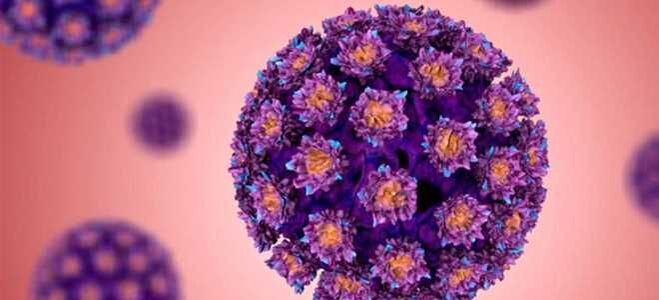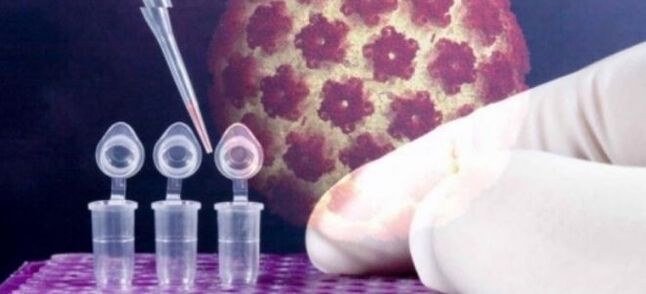
When symptoms and signs of the disease are present, doctors will prescribe many laboratory tests to confirm suspicions and help make a diagnosis. In the appointment list, patients can find an HPV analysis: what it is, why and when it is prescribed - not everyone can answer.
What is HPV?
Human papillomaviruses, HPV, are a whole group of virus-like infectious diseases that are widespread. Scientists know more than 100 species of this virus, and not all of them are dangerous to humans. Most of them remain imperceptibly in the body for a long time and cause transportation. However, about 14 types of this virus are oncogenic - they provoke the development of malignant neoplasms. When making a diagnosis, doctors always pay attention to the type of HPV, its oncogenicity, which determines the further course of action and the type of treatment.
Human Papillomavirus Types
Papillomavirus is usually divided into types according to the risk of provoking the development of oncology. With this factor in mind, there are three main groups of HPV:
- Non-oncogenic- never cause the development of malignant tumors.
- Low oncogenic risk- can provoke the development of cancer under certain conditions: 6, 11, 42, 43, 44.
- High oncogenic risk- If you are infected with these types of HPV, it is difficult to avoid the development of malignant tumors. Oncogenic human papillomaviruses: 16, 18, 31, 35, 33, 45, 58, 59, 52.

How is the human papillomavirus transmitted?
Knowing how papillomaviruses are transmitted can reduce the risk of infection. In practice, however, this is difficult to avoid. In the vast majority of cases, transmission occurs when sexual activity begins: sexual intercourse is the main route of transmission of the virus. The transmission can also occur during a kiss, if there are micro-cracks and scratches on the surface of the lips. You can also get infected if you violate hygiene rules while visiting public places:
- Saunas;
- Swimming pool:
- Bath;
- and also when using someone else's toothbrush, towel, or razor.
Infection can also occur if the baby passes the mother's infected routes during labor. Experts do not rule out the possibility of the virus being transmitted through contact: it is unstable, but it can maintain some activity.Among the factors that provoke HPV infection:
- early start of sexual activity;
- a large number of sexual partners;
- sexually transmitted infections;
- decreased immunity.
Human papillomavirus symptoms
Human papillomaviruses can be invisible in the body for a long time. According to experts, the incubation period can last between 2 months and 2 years. The disease proceeds imperceptibly: there are no clinical symptoms, and the main diagnostic methods show the norm. Every third patient recovers thanks to their immune system within 6-12 months from the time of infection.
The clinic of HPV damage to the body is reduced to the appearance of skin formations. Patients notice papillomas, warts, and condylomas on their skin. Their localization can be different and corresponds to the place of penetration of the virus into the body: genitals, surface of the hand, lips. These formations look like papillary outgrowths, sometimes externally resembling cauliflower. The growths are painless, but if rubbed and injured, they can cause pain and bleeding.

Why do I need an HPV test?
Now that we have talked about the virus, let's move on to information about HPV analysis: what type of research is it, how is it done, and when is it prescribed. First of all, we note that if a human papillomavirus is suspected, the analysis helps to confirm or refute the assumptions. Research of this kind has the following goals:
- Identification of HPV at High Oncogenic Risk;
- Confirmation / denial of persistence of a particular type of HPV;
- Assessment of the risk of cancer in patients with dysplasia of the epithelial layer of the cervix.
In addition to the reasons for the investigation mentioned, the HPV analysis (what it is - stated above) can be shown in the following cases:
- Initial screening for cervical cancer in women over 30.
- Evaluation of the results of the surgical treatment of intraepithelial neoplasia performed.
- Doubtful results of cytological examination of gynecological smears.
What tests should I do for HPV?
There are several methods that can be used to determine the presence of the papillomavirus in the body. However, in most cases, doctors resort to PCR. If HPV analysis is required, patients undergo it directly. Various biological body fluids can be used as test material:
- Blood;
- Urine;
- Amniotic fluid (when diagnosing a disease during pregnancy).
Talking about HPV analysis, what it is and how it is performed, the possibility of examining tissue material should be considered. Therefore, during the colposcopy, the doctor carefully examines the mucous membrane of the cervix. The presence of small papillomas on them is a direct indication of HPV damage to the body. For confirmation, a small piece of tissue is removed for examination under a microscope to rule out malignancy.
HPV diagnostic methods
HPV diagnostics are a series of measures aimed at determining the presence of the virus and determining its type. The following techniques are used for this:
- Digene test- modern precise method. With its help, it is possible to determine the concentration of the virus in the body, its type and oncogenicity. Research material is scraping the mucous membrane of the urethra or vagina. It is often used in combination with cytology.
- PCR diagnosis of HPV- a simple and inexpensive diagnostic method that is widely used. The material used is the patient's blood or urine. Requires the detection of viral DNA traces in the sample.
- Cytological examination- Examination of the smear under a microscope. Evaluation criterion is the presence of modified cells in the smear - dyskeratocytes and coilocytes.
- Detection of antibodies against HPV- helps to detect viral infections in the early stages. The disadvantage is that the concentration and type of virus cannot be determined.
- Histological examination - examination of a sample of the affected tissue to determine the type of HPV and its oncogenicity.

Human Papillomavirus - How To Get Tested?
Before the examination, even during the referral, the doctors give the patient detailed information on how the HPV test will be carried out in each individual case. The analysis algorithm can differ depending on the methods and test materials used. Preparing for the research is of great importance. Correct implementation of all points of the preparatory measures will allow you to get objective results of the analysis and avoid repeated implementation.
Prepare for HPV analysis
Before the HPV analysis, the patient must meet a number of conditions. The survey method and the type of analysis material are of decisive importance. It is represented by:
- Blood;
- Urine;
- a smear from the vagina or urethra.
Depending on the type of biological fluid examined, the patient receives recommendations the day before to prepare for the analysis. The candidate's task is to fully follow the rules of preparation. This avoids false results and, in some cases, false positives when the result indicates the presence of HPV in the absence of it.
HPV blood test
When performing the HPV test, it should be noted that in most cases the patient's blood is used for it. The study is carried out on an empty stomach: 10–12 hours before the expected time of material intake, the patient is not allowed to eat anything, as a drink you can use plain water without gas. The consumption of alcoholic beverages, fatty and junk food is prohibited 2-3 days before the analysis day. Only in this case will the diagnosis of HPV by blood allow accurate test results.
HPV smear analysis
This method is more often used to study the fair sex. Before women are tested for HPV, they are prepared for the exam. The doctor thoroughly introduces the patient to all the rules of preparation. The following important points should be emphasized:
- A smear is taken before the start of the antibiotic treatment or 2, 5 weeks after the end of treatment.
- On the day of sampling, it is forbidden to perform a toilet of the external genital organs with chemical hygiene products.
- It is forbidden to shower, to enter vaginal suppositories.
- You must refrain from sexual intercourse a day before taking the material.
- It is ideal to do a mid-cycle analysis; it is forbidden to conduct a study during ovulation;

Deciphering the analysis of HPV
Only a doctor can properly decipher the results of an HPV test. The specialist assesses not only the quantitative value of the indicators, but also the clinical picture, possible signs of infection. Having a complete picture of what is happening will help you choose the right drugs and effective treatments. At the same time, it is important to take into account the seriousness of timely diagnosis and treatment: with the age of the patient, the risk of developing malignant neoplasms increases.
Quantitative HPV analysis
When performing an HPV test with quantitative analysis, decoding involves determining the virus concentration at the time of the study. This helps determine the right tactics for patient management. Real-time PCR (RT-PCR) measures the amount of HPV DNA in a test sample. This is necessary for the continuous dynamic monitoring of a particular type of human papillomavirus.
But even those who know the HPV analysis, what it is and how it is carried out, cannot decipher the results on their own. This must be done in conjunction with the patient's examination and other examinations. When evaluating, experts adhere to the following interpretation of indicators:
- lg<3- the risk of developing dysplasia is low;
- lg 3-5- if the result is clinically significant, there is a risk of developing cervical dysplasia;
- lg >5- high likelihood of dysplasia, possibly the early stages of the disease.
Qualitative HPV analysis
This technique is used to perform an HPV analysis with a high oncogenic risk. Helps identify the 16th and 18th HPV types. These forms of the virus commonly cause genital and squamous cell carcinoma, genital warts, and cervical dysplasia in women. The detection efficiency of HPV-DNA reaches 98%. The conclusion suggests an answer with a reference to each type of virus. There are two possible outcomes: found / not found.














































































